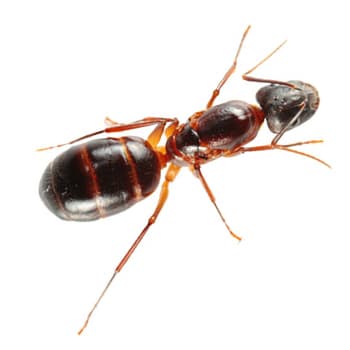How to Get Rid of Carpenter Ants for Good

Have you noticed small groups of dark brown or big black ants crawling through your home in New Jersey, Pennsylvania, Maryland or Delaware? If so, you may want to act sooner rather than later. Pest control experts explain carpenter ants pose a real threat to the structure of your home, and they may also make your house a less-healthy place in which to live. However, you can get rid of them with careful and timely remediation techniques. To protect your home from carpenter ants, you need to learn about the behavior of this pest, take steps for prevention, and find effective carpenter ant treatment options should an infestation occur.
What Are Carpenter Ants?
Carpenter ants are black or dark brown insects about ¼” to ½” in length. Carpenter ants make nests by excavating wood. Carpenter ants bore these holes in wood and leave what looks like wood shavings or sawdust behind. Exterminators explain queen carpenter ants have wings and may look similar to termites; however, they are significantly larger and have different-shaped wings and antennae.
Carpenter ants can cause you frustration and serious damage to homes. Exterminators advise if carpenter ants are left untreated, these boring ants will expand their colonies and cause structural damage to your home.
How Do I Identify Carpenter Ants?
Pest control experts explain carpenter ants in New Jersey, Pennsylvania, Maryland, and Delaware are distinguishable by their size, color, behavior, and the type of wood bits carpenter ants leave behind. Carpenter ants are larger than many other varieties of ants and are always either black or darker brown. While they follow particular pathways, they may not form wide, continuous moving masses of thousands of bodies like army ants do. They also don’t form straight, single-file lines like leaf-cutter ants. Rather, their grouping behavior tends to happen around sources of food or water.
When carpenter ants bore their nests, they must remove the wood. The discarded wood is different than that produced by termites. It looks more like shredded sawdust than a mud-like material. Other than their appearance, this is the best way to distinguish carpenter ants from termites in and around your home.
The damage carpenter ants leave behind is also different than that of termites. Termites leave lots of residue inside their nesting areas, such as mud, insect parts, and remains. Carpenter ants damage is much cleaner—like hollow, empty tubes—because they take all debris out of the nesting area and deposit it outside.
How Do I Prevent Carpenter Ants Within My Home?
Pest control experts believe there are several straightforward ways of preventing carpenter ants. To make sure your home is resistant to them, you can start by getting an inspection from a pest control professional like Viking Pest. We can evaluate your home’s current level of risk, as well as look for previous damage and signs of the ants. We can then use our expertise to take preventative measures to either keep carpenter ants from coming back or getting inside your home.
Removing tree branches that hang over your home is one step we advise homeowners. Carpenter ants like to travel from one nesting area to another, and a dangling tree branch can serve as a bridge to your house. The same goes for landscaping elements on the ground level.
Trim bushes and your grass so they don’t touch your New Jersey, Pennsylvania, Maryland or Delaware home. If your home or business is directly adjacent to a carpenter ant colony, there is a much higher likelihood of them making their way inside.

How Did I Get Carpenter Ants in My Home?
The experts at Viking Pest explain carpenter ants like trees and shrubs, but they will gladly enter your New Jersey, Pennsylvania, Maryland or Delaware home and set up a nest. If you have carpenter ants, it’s likely they discovered your place as they branched out from a nest in a nearby shrub or tree. Also, if you burn wood, carpenter ants can make their way into your home through a piece of wood in the pile when it’s brought inside.
Carpenter ants can also bore nests within stored wood and then migrate throughout other areas of your home. Alternatively, carpenter ants are known to use utility lines to get behind the walls and set up a colony.
What Are the Effects of Carpenter Ants in and Around My Home?
 Even though carpenter ants don’t typically transmit disease by biting, they can carry germs to surfaces that you and your family may come into contact with. Getting rid of carpenter ants, therefore, helps reduce your exposure to potentially harmful germs.
Even though carpenter ants don’t typically transmit disease by biting, they can carry germs to surfaces that you and your family may come into contact with. Getting rid of carpenter ants, therefore, helps reduce your exposure to potentially harmful germs.
The greater danger lies in the effect carpenter ants can have on homes throughout Pennsylvania, Maryland, Delaware, and New Jersey. In order to build their nest, carpenter ants need to burrow away at the wood in your walls, floors, roof, cabinets, or other structures. Like all living creatures, they need water to survive. Therefore, they often prefer moist wood. Pest control experts explain if you have or have ever had water damage, you have a higher chance of getting a carpenter ant infestation.
The larger the colony, the more wood these big black ants will need to eat in order to accommodate their numbers. Because carpenter ants spread from one place to another as they expand their colony, once they are in an area, they may bore away until it is no longer capable of supporting weight or connecting other critical elements of your home.
 “Most carpenter ant colonies are about five years of age when they start producing swarmers, the winged, reproductive ants that fly out to create new colonies,” says Craig S. ACE, PHE, Viking Pest’s Service Director. “Often, they don’t travel very far. It’s not uncommon to find numerous related carpenter ant colonies clustered near each other. These smaller colonies are called ‘satellite colonies.'”
“Most carpenter ant colonies are about five years of age when they start producing swarmers, the winged, reproductive ants that fly out to create new colonies,” says Craig S. ACE, PHE, Viking Pest’s Service Director. “Often, they don’t travel very far. It’s not uncommon to find numerous related carpenter ant colonies clustered near each other. These smaller colonies are called ‘satellite colonies.'”
How Long Do Carpenter Ants Live?
Longevity is one of the carpenter ant’s strengths. Queens can live up to 10 years and workers can live as long as seven years. Because carpenter ants live so long, waiting for a colony to die out is not a viable solution. It’s important to act right away and contact a pest control professional to solve your carpenter ant concerns.
If you’re trying to figure out how to get rid of carpenter ants, the pest control professionals at Viking Pest are ready to help.
Protecting Your Home from Carpenter Ants with Viking Pest
Viking Pest offers expert carpenter ant treatment designed to effectively and efficiently control and prevent carpenter ants from invading your home in New Jersey, Pennsylvania, Maryland, and Delaware. Our use of Integrated Pest Management (IPM) techniques focuses on finding the core of the pest concern and controlling carpenter ants from the source. Through IPM, pest control materials are selected and applied in a manner that minimizes risks to human health, pets, and the environment. Call Viking today for your FREE and NO OBLIGATION carpenter ant extermination estimate at 1-800-618-2847 or schedule online today!
Frequently Asked Questions about Carpenter Ants
You’ll need to locate and destroy any carpenter ant nests on your property to get rid of them. This can be difficult, especially if you live somewhere surrounded by woods or where there’s plenty of decaying wood lying around. Viking Pest Control can help you identify and eliminate nests with safe treatments.
Beyond that you’ll need to:
•Remove any decaying wood on your property.
•Repair any damaged wood that might attract carpenter ants.
•Get rid of old stumps and fallen branches on your property.
•Double-check that your property doesn’t have drainage issues that could lead to standing water or moisture buildup.
•Inspect trees for dead branches and holes that are commonly infested. If you find any, call an appropriately trained and licensed arborist.
Carpenter ants, like most pests, are attracted to areas that provide their basic needs. They seek out moisture, food, and shelter. These ants tend to look for:
• Decaying and damp wood: Carpenter ants make nests in wood. Soft or rotting wood is easier for them to excavate.
•Moisture: Carpenter ants need a steady source of moisture. They love areas with standing water or leaks.
• Firewood: Firewood provides an easy home, especially if it’s stacked on the ground. If that stack is by your home, your walls could be their next target.
•Access to sweet foods: Sugary foods like honey and syrup are similar to the honeydew produced by aphids and other insects.
• Gardens filled with aphids, spotted lanternflies and similar pests: Carpenter ants love honeydew, a sweet, sticky liquid byproduct of aphids, spotted lanternflies and other plant eating.
• Pet food: The fat and protein in pet food can attract hungry carpenter ants.
Yes, carpenter ants bite. Due to their size and strength, these bites can break the skin and be painful. Carpenter ants may also spray formic acid, which irritates the bite and creates a burning sensation. However, their bites are generally considered harmless to humans. They also only bite of they feel threatened or their nests are disturbed.
Though carpenter ants will chew through wood, they don’t eat it. Instead, they primarily live on a diet of other insects, honeydew (the liquid produced by aphids and other plant parasites) and any sweets they can find. They’re particularly attracted to jelly, sugar, syrup and honey.
Carpenter ants are a large ant species. Adult worker ants tend to be around 1/2 inch in length, but the queens may grow to sizes around an inch. Suspect carpenter ants if black and larger than a grain of rice
Yes, some carpenter ants can fly. However, it’s only the reproductive adults, male and female, that have wings. They fly and swarm to mate, then shed their wings to find a suitable nesting site.














